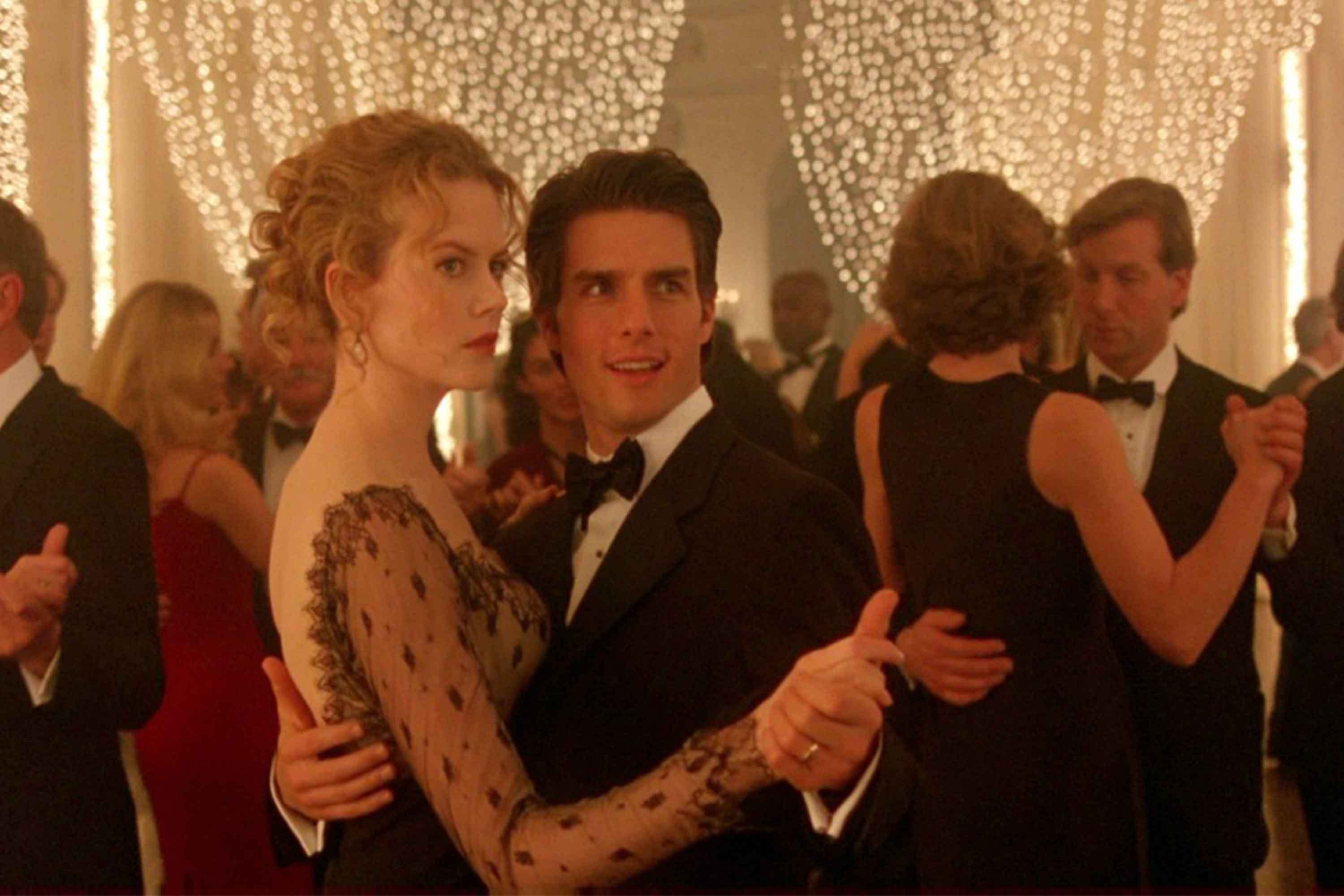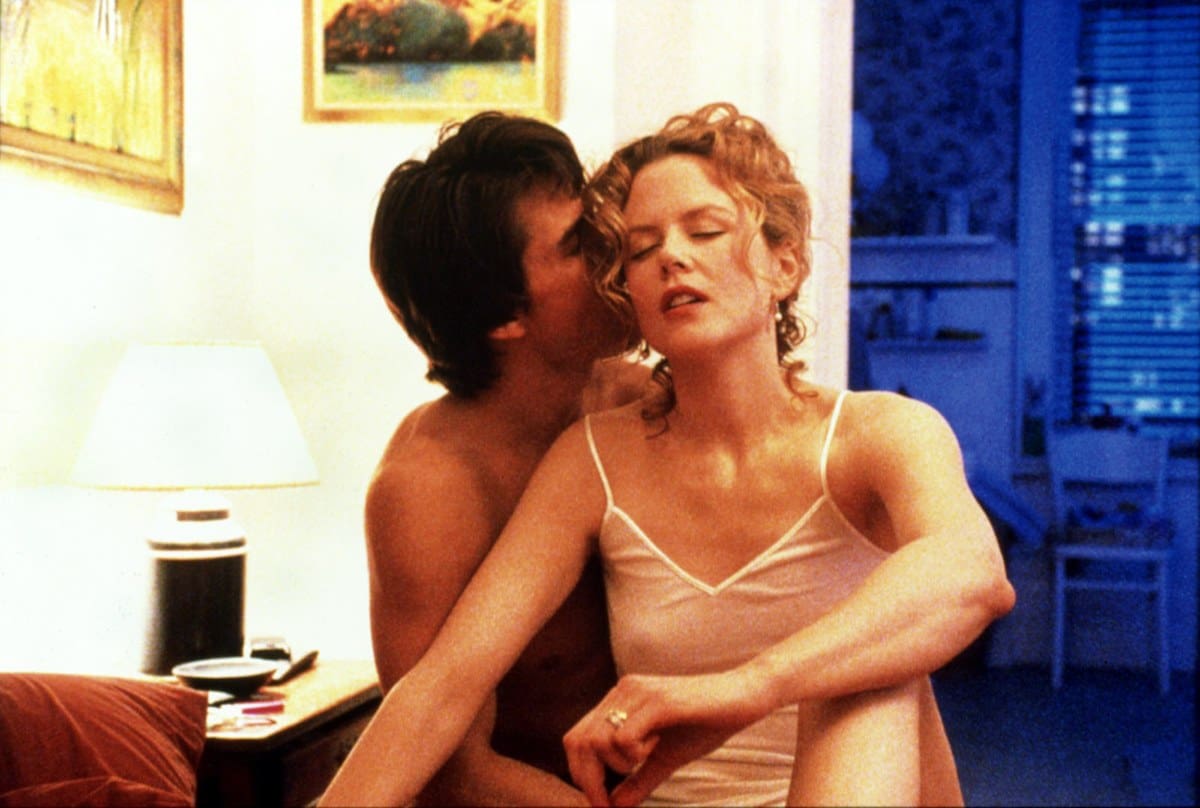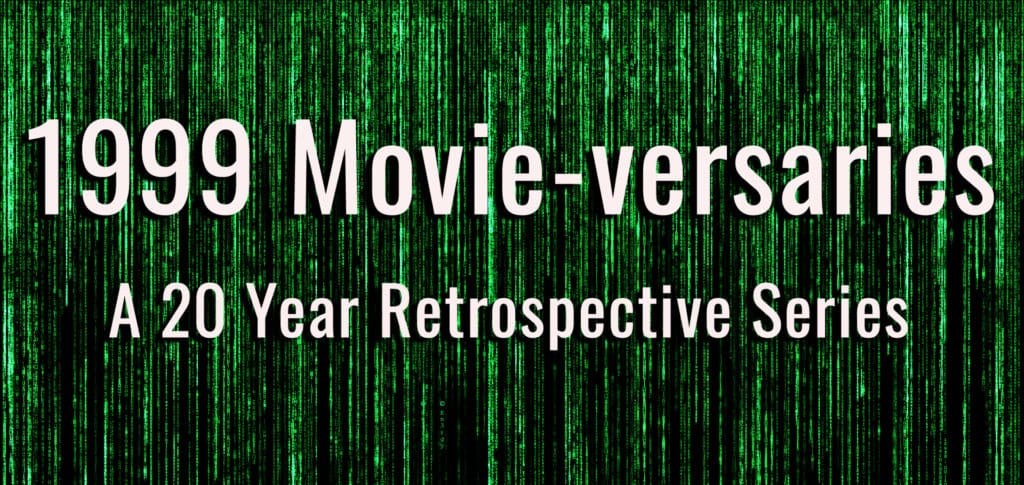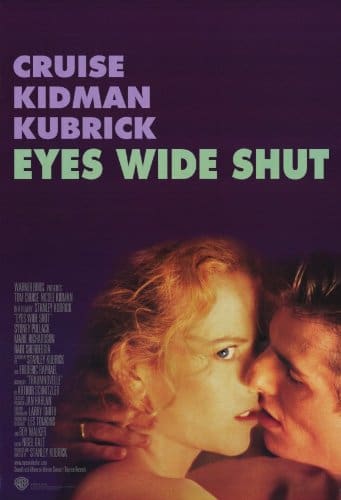1999 was a big year for movies. It was the year that The Matrix‘s slow-motion bullet influenced action movies for years to come. It was the year American Beauty won Best Picture at the Academy Awards and Oscar fans have been arguing about it ever since. It was the year Pokémon jumped from Gameboys and TV to the big screen. And worst of all, it was the year that disappointed a generation of Star Wars fans with the release of The Phantom Menace.
To celebrate that landmark year in film’s 20th Anniversary, The Pop Break continues its year-long retrospective of 1999’s most influential (at least to us) films with staff writer, Dylan Brandsema, reflecting on his opinions on Eyes Wide Shut have evolved over the years.
I first saw Eyes Wide Shut in high school — sophomore year, I think it was. I had recently proclaimed Stanley Kubrick as my favorite film director of all time (a sentiment that it still mostly true) and I was making way through his short but diverse filmography one film at a time. This was before streaming dominated everyone’s media library, but also after the downfall of my local Blockbuster. If I wanted to see every Stanley Kubrick film, I had to order the physical copies off eBay and with my parents’ money, this is exactly what I did.
Eyes Wide Shut was an anomaly to me then. I knew films like The Shining, 2001: A Space Odyssey, Full Metal Jacket and even the ultra-violent A Clockwork Orange to an extent had become classics, films ingrained in popular culture that everyone knows even if they haven’t seen them. But this movie, made after a large gap in his filmography, with A-listers Tom Cruise and Nicole Kidman, that didn’t get released until after Kubrick died, just seemed of no note to me. It wasn’t part of the pop culture umbrella in the same way most of his other movies were. To characterize it plainly, it was to Stanley Kubrick what “Calling All Stations” was to Genesis.
When I finally did see it, I didn’t get it. I didn’t understand why the masked ball scene was so long, I didn’t understand why there were so many scenes of Tom Cruise walking down the street alone. I didn’t understand what the point of the Domino sequence was. I didn’t understand. I was naive. And somehow, when my first viewing ended, I sat in silence even after the credits for what must have been a handful of minutes. I was shell shocked by this film I had no understanding of conceptually or philosophically and I was bewildered by the fact that this was the final work of my favorite director, the untouchable, immortal Kubrick.
It’s now been 20 years since Eyes Wide Shut’s release, and about a decade since I first saw it. The film now sits in my Top 10 of all time—a pedestal from which is it unlikely ever to move. And even if it hasn’t become a so-called modern classic like Kubrick’s other works were in 1999, it is undeniable that it has become a part of popular culture, and its initial mixed to negative critical reception has been turned mostly completely upside down.
To understand what makes Eyes Wide Shut different from the rest of Kubrick’s works, we have to take into consideration first and foremost his output between 1968 (2001) and 1987 (Full Metal Jacket). 2001: A Space Odyssey put Kubrick into the stratosphere (pun intended) of the generation’s great American directors, and with succeeding films, he became a household name. These films, plus the lesser known but still masterful Barry Lyndon (‘75), are the works that defined Kubrick for a long time for an entire generation of filmgoers.
All of them are distinct and different in both genre and structure, but they all share the same explosive characterization of their respective categories. The uncontrollable chaos of The Shining is a tool synonymous with psychological horror storytelling. The gorgeous landscapes and glossy cinematography in Barry Lyndon have become signature tools of visualizing past century period pieces. The vast silence of space has become a key element in movies set in outer space since 2001. And so on and so forth.
Secondly, we have to consider the 12 year gap between 1987’s Full Metal Jacket and the posthumous release of Eyes Wide Shut in 1999. There’s a common misconception that EWS took this entire 12 years to make. In fact, this period–primarily from about ‘88 to about ‘95–was filled with a number of unrealized projects. For years, Kubrick wanted to make a Holocaust film titled The Aryan Papers, based on Louis Begly’s acclaimed novel Wartime Lies. Pre-production, which itself took years, got so far as securing a lead actor and funding, but Kubrick ultimately scrapped the project shortly after the release of Schindler’s List. After this, he set his sights on directing what eventually became Steven Spielberg’s A.I.: Artificial Intelligence. Alas, he walked away from that project too, thinking he was too cynical for the material. We could go on and on for an entire essay’s length about his constant revisiting of his previously failed Napoleon film.
So, what happens when a hugely popular, almost universally acclaimed director all of sudden finds himself with no director credits for over a decade? What goes through their mind? For purposes of character analysis, it’s probably safe to say Eyes Wide Shut is Stanley’s most personal film. Or, at least, his most human.
In comparison to his other works, everything about it is intentionally untheatrical. There are no explosions of soundtrack, no crazy montages, no characters losing their minds or screaming at the top of their lungs. This is a quiet, subdued, almost completely dialogue-driven portrait of what happens when secrets and unspoken desires work their way to the surface in an otherwise functional marriage. It’s easy to understand why critics and audiences were slightly disappointed in 1999 when the master Stanley Kubrick’s first film in over a decade was essentially three hours of talking heads.
There’s a quote from Kubrick that I’ve always loved: “If it can be written, or thought, it can be filmed.” Thought is my favorite part of that. Eyes Wide Shut is a film about thoughts: bad ones, unspoken ones, uncomfortable ones, filthy ones. This is also why this film undeniably has one of Tom Cruise’s greatest performances as a dramatic actor. Just a shot of Bill Harford swiveling nervously in his office chair by himself or walking down the street looking frantically at every building is enough to get us to understand his headspace. He’ll do anything, go anywhere, to avoid having to go back to Alice after their inciting argument. Even shacking up with a prostitute is not off the table.
That argument, the long, 10+ minute scene of Cruise and Kidman in their bedroom, has historically been one of the film’s most criticized sequences. In it, the couple smokes pot after a long night at a party. They start wondering about each other’s behavior while they were away from each other, and it spirals into a debate about the desires of and differences between men and woman, the untouched desire to be unfaithful, and the meaning of their marriage. Many have said that the acting in this scene is unnatural, that that’s not really how people talk when they’re high, or that the argument turns hostile too quickly, but I beg to differ.
We understand the waning nature of the Harford’s marriage within the first few minutes through two small moments: First, in the very beginning in the bathroom when Bill tells Alice her hair looks nice without even looking at it. She’s comfortable enough around Bill to use the toilet in front of him, but she resents that even still, he doesn’t pay enough attention. The second instant is just a few moments later, when Alice mentions the hired babysitter by name, and then almost immediately after, Bill, as if he ignored everything she just said, asks what the babysitter’s name is. She repeats it, but doesn’t call him out on his ignorance. When we first meet the Harfords, their relationship has already reached the stage of simply putting up with one another for the sake of parenthood. The rapidly escalating argument that acts as the film’s inciting incident is completely earned and to say otherwise is to not pay close enough attention to the little details.

As far the acting, I find it hard to believe that anyone can watch this scene from beginning to end completely in context and not consider it a damn fine piece of nuanced acting from Nicole Kidman in particular. Look at the way she smiles and smirks down at Bill at the end when she’s finishing her story about the sailor. His eyes widen in shock, struggling to process what he’s just heard, and she now has the higher ground by making him feel, even for an instant, that a random sailor boy she only saw from across the room could satisfy her better sexually than he could. She’s won this battle of wills and now Bill must reassess his whole being. Even if the argument itself is rather bombastic, it’s also a masterclass in subtle acting and the scene is a masterpiece.
Naturally, this brings us to the masked ball sequence, and the subsequent orgy. There was much controversy upon the film’s release about the amount of female nudity in this sequence. Some say it’s excessive, but that’s only true if you take away the point of view. In this sequence, thanks quite literally to a moving dolly POV shot that lasts a good minute, we are Bill Harford.
We have no idea what’s coming next or how long it will continue. The nudity in this sequence has never struck me has arousing. Shocking, maybe appealing, but never stimulating. To Bill, and to us, every woman in this sequence is an embodiment of temptation and insecurity. When the woman kisses Bill mask-to-mask, he’s reminded of what he could have if he were free of his marriage. To say the nudity is excessive or that the sequence is needlessly graphic or too long is to take away the frightening, nerve-wracking nature the entire ordeal has on our protagonist, and subsequently, on us. This is a film about sexuality, but not sex. It’s about the consequences of carnal lust, but never the act of it.
This, in turn, brings us to the ending, or rather, almost to it. Towards to the end of the film, Zigler (Sydney Pollack) calls Bill over to explain everything to him—the meaning of the masked ball and the orgy, why he was able to go home, and even the strange man following him as he wanders around the streets. When I first saw this scene, I kind of hated it. I was already bewildered enough by this point, and I didn’t think it benefited from having the vanilla explanation given in this long sequence. In more recent viewings, though, I’ve come to believe that not everything said in this scene might be true.
There’s just…something about Zigler’s demeanor that comes off to me as trying to desperately ease his friend’s concerns. This, of course, is a testament to the great acting of the late Pollack. Is he making this all up so Bill doesn’t gossip that Zigler is part of a crazy sex cult? Is Amanda Curran’s death really unrelated, or did they kill her because she interacted with an outsider? It wouldn’t be the first instance in the film in which the narrative is trying to deceive us.
Take, for instance, in the opening bathroom scene when Bill turns off the stereo and the music we thought was non-diegetic abruptly stops. This happens again in the exact same fashion later at Domino’s (Vinessa Shaw) house when Bill turns down her sexual advances. Kubrick fools you once, shame on you. Kubrick fools you twice, shame on you and the horse you rode in on. If he fools you three times, would you even know it? A terrific quote from the great Roger Ebert’s review in ‘99 says, “To begin with, can Dr. Bill believe Victor’s version of the events of the past few days? I would have enjoyed a final shot in a hospital corridor, with Dr. Bill doing a double-take as a gurney wheels past carrying the corpse of the piano player.”
Another example of something that just doesn’t quite add up: Nick Nightingale (Todd Field), the masked ball organist, says the event happens in a different place every time, but later, when Bill returns to the place where it happened, he is almost immediately greeted with an ominous letter saying to stay away.
My favorite thing about the film, above all else, is that it has no climax. Not that it doesn’t have a proper story ending, but emotionally, the Harfords and the viewer are never let off the hook. When Bill tells Alice that he’ll, “tell her everything”, we don’t see it. We only cut to the aftermath, as Kidman sits drained of energy and emotion, smoking a cigarette. In the final scene, Alice in turn tells Bill that they need to make love to each other as soon as possible.
If this were a film about sex, this would be the climax of the film. It’s easy to imagine. Bill and Alice in bed together having savage, angry sex fueled by repressed emotions, the film then ending with one of them having some sort of irreversible violent reaction on the other as a revenge for all the lies and deception. But we don’t get closure, we don’t get our experience wrapped up with a nice handshake and a kiss goodbye. This must be why I sat in silence and stared at the screen for so long when my first viewing ended: I didn’t want to believe it was over. Surely, there has to be more to say. But of course, by this point in his career, this is the level of crazy narrative control Kubrick had over his stories.

In the end, what is Eyes Wide Shut really about? In 20 years, I don’t think the film community has collectively agreed on a definitive interpretation. Many say it’s simply a film about the fundamental differences between men and women, but I wouldn’t put it, to quote Bill Harford himself, “that black and white”.
Sometimes I think that it’s meant to imply that although love between man and woman can exist, marriage is unnatural because it squanders human desire, or at least, that it is not meant to last forever. Other times, I think it’s stating that if a marriage between two people is to last, they must share every single thought with one another—even ones of infidelity and possible deceit. I don’t think it’s possible, or even meant to be analyzed one way over another. In this way and only in this way does Eyes Wide Shut fit in stylistically with the rest of Kubrick’s oeuvre, making it one of his absolutely best works. There exists an entire feature length documentary dedicated to picking apart the possible interpretations of The Shining. Maybe on its 40th anniversary, someone will do the same for Eyes Wide Shut.
I will not indulge in diving into the cornucopia of conspiracy theories that have surrounded this film since its release. No, I don’t think Kubrick was, “murdered by the Illuminati”, nor do I think that Kubrick had any plans to make this his last film. We know for a fact, even, that Kubrick continued to work on A.I. as a producer quite literally right up until his unfortunate passing.
As a swan song to a 5-decade long career, Stanley Kubrick’s Eyes Wide Shut is like a thousand exclamation points on the end of an extremely long, extremely detailed sentence. He only made 13 feature films in half a century, but every one of them is a conversation about something other than themselves. He made films that went beyond the narrative, beyond the conversation at the water cooler. I can’t even recall how many times I’ve referenced 2001 in conversations about technology and the future of the human species, or how many times I’ve mentioned Paths of Glory when having a debate with somebody about the morality/actions of our military.
Eyes Wide Shut has permanently affected how I’ve viewed every long-standing relationship I’ve ever been in. I recall one distinctive memory from high school where I was at the lake with my girlfriend at the time, some of my friends, some of her friends and everyone’s parents for a big BBQ party on the lake. There was a moment when my girlfriend (for the sake of conversation, let’s call her “Alice”) stared at one of my friends for a long time when he was coming out of the water. It unnerved me for a minute, but then I put it out of my mind and went about my business. Maybe one day in the future I’ll ask her about it, or maybe I’ll go for a walk. Maybe I’ll keep my eyes shut.
[A closing note: The Blu-Ray of the film currently available from Warner Brothers finally presents the film unedited, without the CG figures originally inserted to hide some of the more graphic nudity and sex during the masked ball orgy, which still existed on the previous VHS and DVD releases. It’s a travesty that it’s taken 20 years for audiences to finally be able to see the uncensored version. I will never, ever understand the decision to censor a film made by an adult, targeted at other adults for the sake of younger viewers.]



